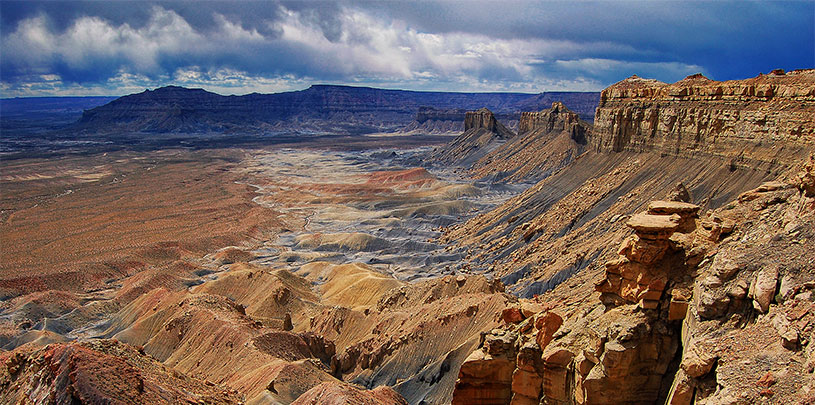
 by Lisa Winters, Communications Manager
by Lisa Winters, Communications Manager
Spanning more than 1.8 million acres of southern Utah, Grand Staircase-Escalante National Monument is a vast, arid landscape of Indigenous histories, slickrock and slot canyons, and jaw-dropping desert wildlife diversity, including over 600 species of bees.
Step back in time millions of years, however, and Grand Staircase-Escalante National Monument transforms into a lush, swampy wonderland whose rivers flow into a nearby inland sea. That warm, wet climate hosted countless dinosaur species.
How do we know this? Hidden in Grand Staircase-Escalante’s geologic steps are clues to the ancient past, carefully preserved as fossils in the rock layers that we see across the monument today.
From marine reptiles to horned dinosaurs to petrified logs, the monument is full of fossils. Here are four fun facts about the paleontology of Grand Staircase-Escalante.
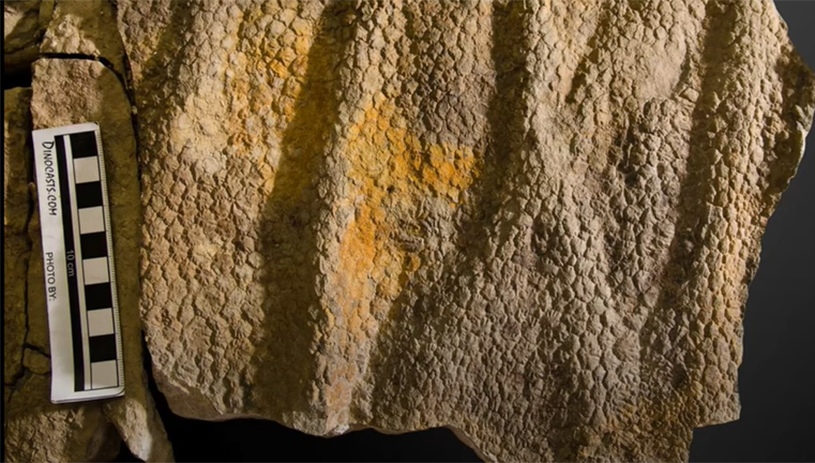 Fossilized duck-billed dinosaur skin. BUREAU OF LAND MANAGEMENT
Fossilized duck-billed dinosaur skin. BUREAU OF LAND MANAGEMENT
From the origin of the first dinosaurs during the Triassic period 252-201 million years ago, to the Jurassic period 201-145 million years ago, and finally the Cretaceous period 145-66 million years ago, southern Utah was a popular place for dinosaurs to call home. The now dry, rocky expanse was a swampy forest in the Cretaceous period, with giant pine trees, ferns, duckweed, and flowering plants — a tasty buffet for its large dinosaur residents.
The rock that makes up the Kaiparowits Plateau, a 1,650-square-mile area of sandstone and mudstone in the central part of the monument, holds lots of dinosaur fossils because sand and mud could quickly bury the still-intact fossils. Today, the eroding rock exposes fossils at the surface. The number and variety of intact fossils in Grand Staircase-Escalante is unmatched — right down to the individual scales making up the skin of a duck-billed dinosaur’s back or the veins of a leaf frozen in time.
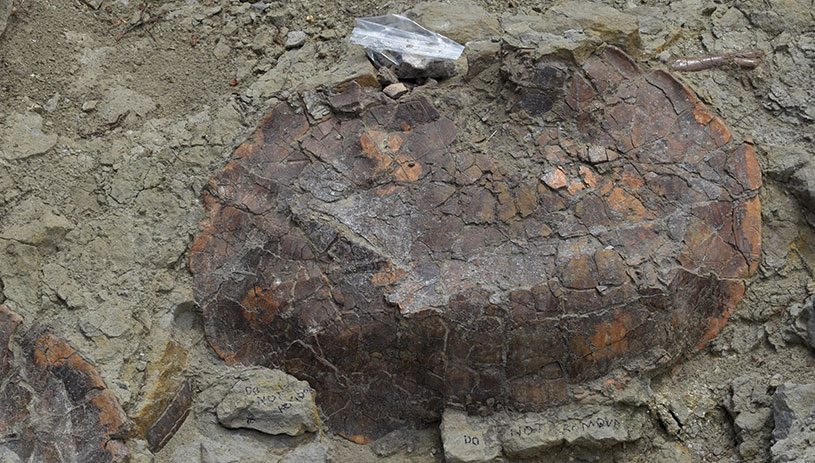 A prehistoric turtle shell. SCOTT RICHARDSON, BUREAU OF LAND MANAGEMENT
A prehistoric turtle shell. SCOTT RICHARDSON, BUREAU OF LAND MANAGEMENT
At least 15 dinosaur species unearthed in Grand Staircase-Escalante National Monument are found nowhere else on Earth. Many are horned-faced dinosaurs or duck-billed dinosaurs. Scientists have found small, feathered meat-eating dinosaurs and a 30-foot-long tyrannosaur. Another memorable find — an almost complete skeleton of a plant-eating armored dinosaur with a club tail.
But it’s not just dinosaurs. Fossils of ancient turtles, small land-based crocodiles, shellfish, and plants are also found in the rock layers of Grand Staircase-Escalante. Put together, the monument’s fossils paint a picture of past environments and all the organisms that inhabited them long ago.
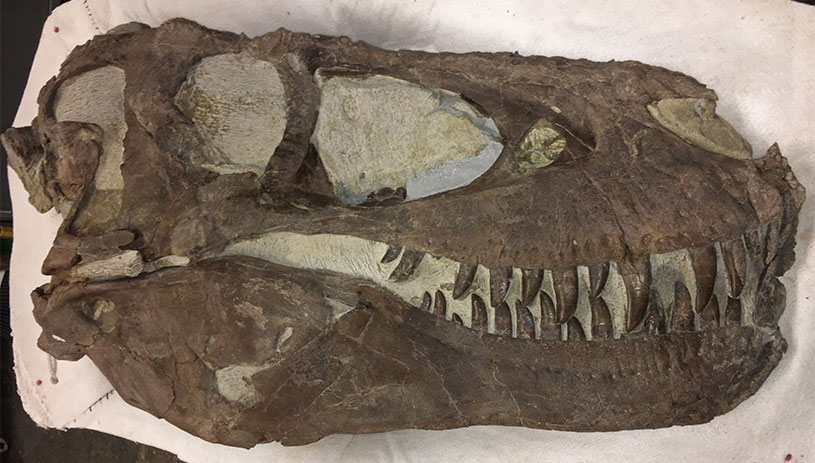 A Teratophoneus skull. ALAN TITUS, BUREAU OF LAND MANAGEMENT
A Teratophoneus skull. ALAN TITUS, BUREAU OF LAND MANAGEMENT
Did you know that the word “Teratophoneus” — a dinosaur related to the Tyrannosaurus rex — means “monstrous murderer” in Greek? Back in 2014, paleontologists discovered a group of fossils in the Rainbows and Unicorns Quarry of the Kaiparowits Plateau region of the monument. Among the finds were four Teratophoneus dinosaurs — young and old — that indicated these dinosaurs were social creatures that lived and hunted in groups, like today’s wolves.
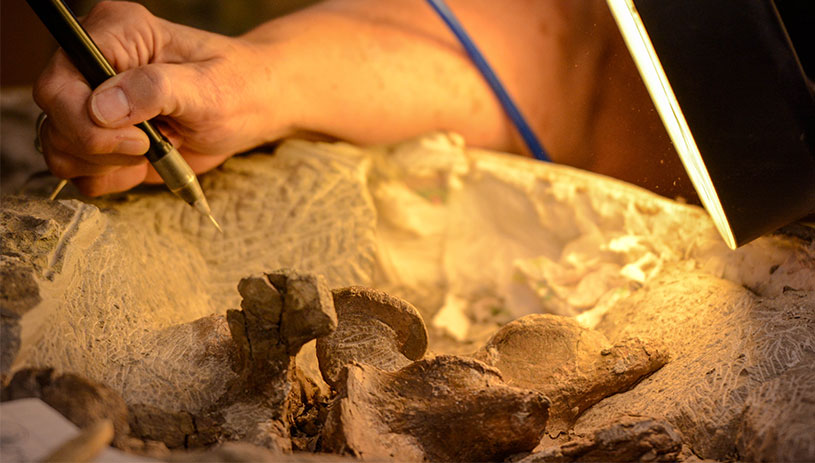 A paleontologist carefully uncovers a tyrannosaur bone in the lab. RYAN SUTHERLAND, BUREAU OF LAND MANAGEMENT
A paleontologist carefully uncovers a tyrannosaur bone in the lab. RYAN SUTHERLAND, BUREAU OF LAND MANAGEMENT
Finding a dinosaur fossil is just the beginning. Paleontologists carefully excavate, prepare, describe, and name these new finds. They piece together information about an individual with clues from its surroundings. And they date the fossils based on the rock in which they’re buried — often by measuring the amount of a radioactive element left in the material. Because the Grand Staircase-Escalante region has such a good fossil record, scientists can track the evolution of life on Earth — from the appearance of flowering plants to the evolution of dinosaurs into birds.
Mammals, frogs, lizards, and smaller creatures also help tell a story about the changing climate, as temperatures, and plant and animal communities, shifted with moving landmasses. The Grand Staircase-Escalante region holds such a complete picture of life on Earth that the sudden disappearance of dinosaurs from the fossil record about 66 million years ago is clear.
 A tooth fossil found in the monument. BUREAU OF LAND MANAGEMENT
A tooth fossil found in the monument. BUREAU OF LAND MANAGEMENT
The study of dinosaur fossils is just one way that the unique geologic story found in Grand Staircase-Escalante National Monument continues to unfold, one step at a time.
80% of Arizona voters support Baaj Nwaavjo I'tah Kukveni National Monument, according to a new poll.
Read MoreUtah voters strongly support national monuments in general, and Bears Ears and Grand Staircase-Escalante in particular, a new poll shows.
Read MoreA small victory in the legal case challenging Daneros uranium mine, near Bears Ears National Monument.
Read More